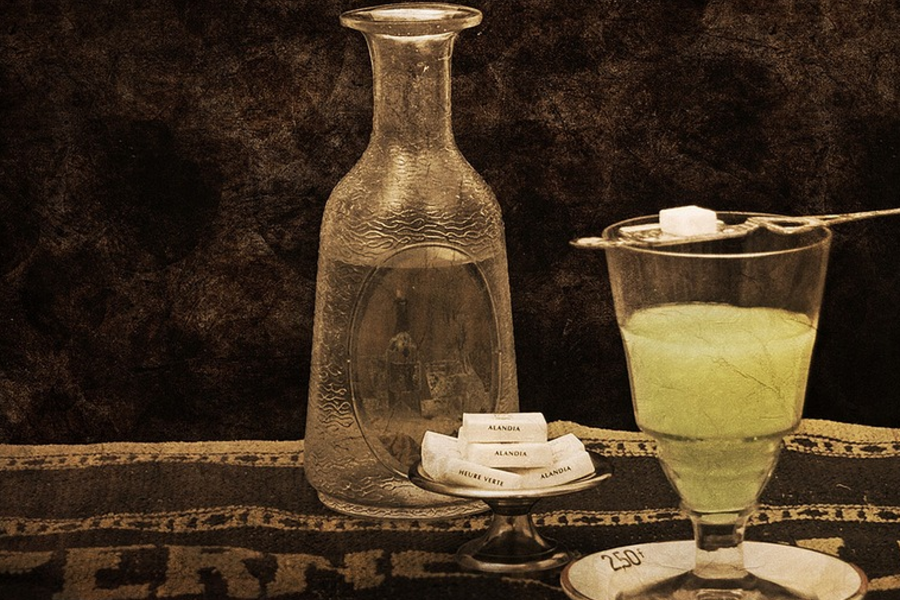
Absinthe, often known as the "Green Fairy" because of its vibrant colour and mystical reputation, is a drink with a rich history and a certain amount of mystery surrounding it. This strong drink has found its place in the culture of artists, writers and bon vivants over the centuries. In this blog, we dive deeper into the origins, special history and intriguing taste of this legendary drink.
The origins of Absinthe
Absinthe was first produced in Switzerland's Val-de-Travers in the late 18th century, although the drink was originally based on ancient herbal drinks. The modern version of absinthe is often attributed to French physician Dr Pierre Ordinaire, who in 1792 developed a distilling process in which he made absinthe from wormwood (Artemisia absinthium), anise and fennel, along with other herbs. This drink was first sold as a medicinal remedy, as wormwood was praised for its alleged medicinal properties.
In the early 19th century, absinthe became increasingly popular in France, especially when French soldiers used it during campaigns to fight diseases such as malaria. After their return, absinthe's popularity spread rapidly, especially in Parisian cafés, where it became known as the favourite drink of bohemians and the elite alike.
Absinthe's mystical past
Absinthe was known as more than just an alcoholic drink; it gained a reputation as a source of creativity and inspiration. Famous artists and writers such as Vincent van Gogh, Pablo Picasso, Oscar Wilde and Ernest Hemingway were avid absinthe drinkers. This cultural elite often called it the "Green Fairy" because they believed it gave them visions, creative insight and inspiration.
Towards the end of the 19th century, however, absinthe fell into disrepute. The combination of its high alcohol content (usually around 45-74%) and the use of wormwood, which contained thujone, a substance that can be toxic in high concentrations, led to rumours that absinthe caused hallucinations and even madness. Stories were spread of absinthe users committing violent acts, leading to a growing public outcry.
In 1915, absinthe was eventually banned in many countries, including France, the United States and Switzerland, due to the alleged health risks and moral panic surrounding the drink. It was only in the late 20th and early 21st centuries that it became clear that the hysteria surrounding absinthe was exaggerated, and it was legalised again, albeit with stricter regulations regarding its thujone content.
The taste of absinthe: a unique experience
Absinthe is a complex drink with a distinct flavour that is not for everyone. Its main ingredient, wormwood, gives it a slightly bitter, herbaceous taste. Together with aniseed and fennel, absinthe also acquires a distinctive sweet and spicy flavour reminiscent of liquorice or liquorice. Some absinthe also contains other herbs such as coriander, melissa, or angelica, which add extra depth to the taste experience.
The Right Way to Drink Absinthe
Drinking absinthe pure is generally not recommended because of its high alcohol content and intense flavour. Traditionally, it is served according to a ritual that originated in the 19th century. This ritual is as important to the experience as the flavour itself.
- Pour a small amount of absinthe into a glass.
- Place a specially perforated absinthe spoon on the glass and place a sugar cube on top.
- Slowly pour cold water over the sugar cube until it is dissolved and the absinthe begins to "louch" (take on a milky, cloudy colour due to the essential oils dissolving in water).
- Stir gently and enjoy the delicate flavours.
Absinthe in the Modern Age
Today, absinthe is popular again, especially among whisky lovers and cocktail enthusiasts looking for something with a rich heritage and unique flavour. Many modern absinthe brands are produced with carefully controlled amounts of thujone, which ensures that the drink is safe to drink while retaining its distinctive spicy and bitter character.
Well-known absinthe brands such as Pernod, La Clandestine, Tabu, La Fee and Kübler have contributed to the revival of absinthe, with a focus on artisanal production and the preservation of traditional methods. Absinthe is also increasingly used in cocktails such as the Sazerac and Corpse Reviver No. 2, where it adds subtle anise and spice flavours.
The Green Fairy lives on
Absinthe is a drink with a rich and sometimes controversial history, having been both loved and feared over the years. Today, it returns as a respected spirit that, with the right techniques and rituals, reveals its true character. Whether you appreciate the subtle flavours of spices or are fascinated by the cultural and historical aspects of absinthe, it is a drink definitely worth exploring.
Cheers to the "Green Fairy" and its timeless magic!

Blogger
The text you've just read was (partially) created with the help of ChatGPT . Although every story we write is thoroughly proofread and corrected with the help of ChatGPT, it can always happen that an error has crept in here and there that you, as a seasoned connoisseur, do not agree with.
Therefore, if after reading this blog you do not agree with certain statements that are put forward, please do not hesitate to let us know via service@broekmans.be so that we can further edit this text.
It is a conscious decision to explicitly mention that this blog article was written with the help of AI, as nothing is more valuable than the work, preparations and efforts made by "real" bloggers when they publish blog articles on our webshop (or elsewhere) that are not supported by AI.







